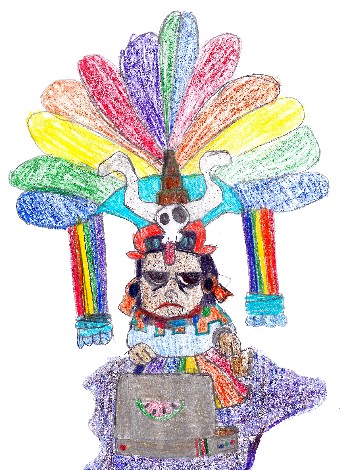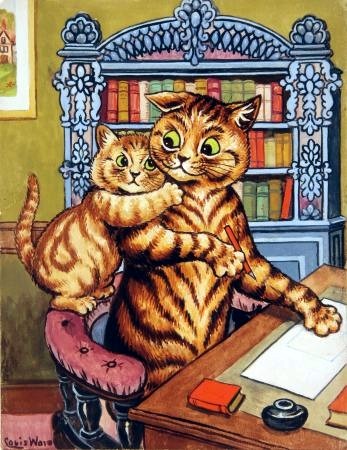And the Pizza Prize Winner is…
By Hope Wallace

Caton Williamson, age 10, from Van Wert! Caton attends St. Mary’s School and she will get a free yummy, any size/any kind pizza sponsored by Pizza Hut, Van Wert. We were really happy to see the varying renditions of our source drawing submitted to the Wassenberg Art Center! We will post another drawing for “pencil for pizza” next week. See what you can come up with! This contest is open for ages 5-18 and can be rendered in any media. We encourage you to experiment and use your own style! Congratulations, Caton!
It’s absolutely wonderful when I can use the word “congratulations” more than once in a column. Our heartiest congratulations to all the award winners in our Photography exhibit. It is an honor and pleasure to be able to hand out concrete recognition for work which people enjoy creating and make this world a better place. Thank you all for coming out to the 34th Annual Wassenberg Photography Exhibit reception.
Our 34th Annual Photography Exhibit runs until October 28. Lush color abounds. The gallery is open Tuesday–Sunday, 1–5 p.m. The exhibit is sponsored by Citizens National Bank, Purmort Brothers Insurance, Central Insurance Companies, and the Van Wert County Foundation.
There are still some spaces available for our one-day and multiple day classes. Give us a call and see if we can work something out for you.
For any questions please contact the art center at 419.238.6837 or via wassenberg@embarqmail.com. The Wassenberg Art Center is located at 643 S. Washington St. in Van Wert.
Louis Wain: The artist of Catland
By Kay Sluterbeck

Louis Wain (1860-1936) was born in London, England, to an artist father and a textile-designer mother. As a child he was fascinated by colors and amused himself for hours by arranging colored leaves. By 1877 he was studying in the West London School of Art, and was soon selling drawings to newspapers.
Around 1883 he fell in love with a governess, Emily Marie Richardson, who was ten years his senior. The age difference was scandalous for the time, but Louis and Emily married in 1884 and were blissfully happy until it was discovered, shortly after the wedding, that Emily had cancer. She was bedridden for 19 months and died in 1887. Louis never remarried.
During her illness, Emily was comforted by their playful black-and-white cat, Peter. To amuse his wife, Wain taught Peter tricks, such as wearing spectacles and pretending to read. During long hours by Emily’s bedside, he drew detailed sketches of Peter, which he sold to magazines. Wain later wrote of Peter, “To him properly belongs the foundation of my career, the developments of my initial efforts, and the establishing of my work.”
His cat drawings were realistic at first, but in late 1886 he created what became known as the “Wain cat,” using Peter as a model. He drew the well-nourished, round-faced English cat, stood it on its hind legs, gave it bigger eyes and a smile, dressed it in human clothing, and presented it to the public in November 1886, when his article “A Kitten’s Christmas Party” was published in the Illustrated London News. It was the start of an amazing career. Soon he was famous and turning out an average of 600 cat designs a year.
From 1890 to 1914 he illustrated quantities of books and designed hundreds of colored postcards showing cats doing human activities, sometimes dressed in human clothes. He illustrated about 100 children’s books, including the well-loved “Catland” books, and his work appeared in papers, journals, magazines, and the Louis Wain Annual, which ran from 1901 to 1915. He drew and painted other animals, but it was cats, and his unmistakable way of drawing them, that made his name.
Not surprisingly, Wain was intensely fond of animals, especially cats. He was involved with numerous animal charities as well as the National Cat Club, always had several pet cats and dogs, and would walk miles out of his way to take a stray cat home with him.
Despite his popularity, Wain suffered financial difficulty throughout his life; he had little business sense, and was supporting his four unmarried sisters.. With the onset of the war in 1914, he could no longer make money through his art. His work was still popular, but everything that was published had already been paid for in advance, and unfortunately there were no royalties because he always sold his work outright. He remained famous but became much poorer.
Around 1918 Wain began to have serious attacks of delusion. Eventually he became convinced that he had no money at all, and that he and his sisters would be thrown out of their home without their belongings. He spent hours moving furniture around the house in hopes of hiding it from imaginary bailiffs. By 1924 his sisters could no longer care for him, and he was confined to an asylum for paupers.
A journalist discovered his plight and Wain’s circumstances were widely publicized, leading to appeals from such luminaries as author H. G. Wells and the personal intervention of the Prime Minister. A fund was established, allowing him to be moved to a private ward in Bethlem Hospital. In 1930 he was moved to Napsbury Hospital, north of London. It was a fairly pleasant place, with a garden and colony of cats, and he spent his final 15 years there in peace. The nature of his condition is disputed; although he was diagnosed with schizophrenia, at least one expert has speculated that he may have had Asperger sydrome because his artistic technique and skill did not diminish.
He continued to paint and draw for pleasure, with his later artwork marked by bright colors, flowers, and intricate patterns, usually including cats. He died in 1936. H. G. Wells said of him, “He has made the cat his own. He invented a cat style, a cat society, a whole cat world. English cats that do not look and live like Louis Wain cats are ashamed of themselves.”
POSTED: 10/05/11 at 2:55 pm. FILED UNDER: What's Up at Wassenberg?







